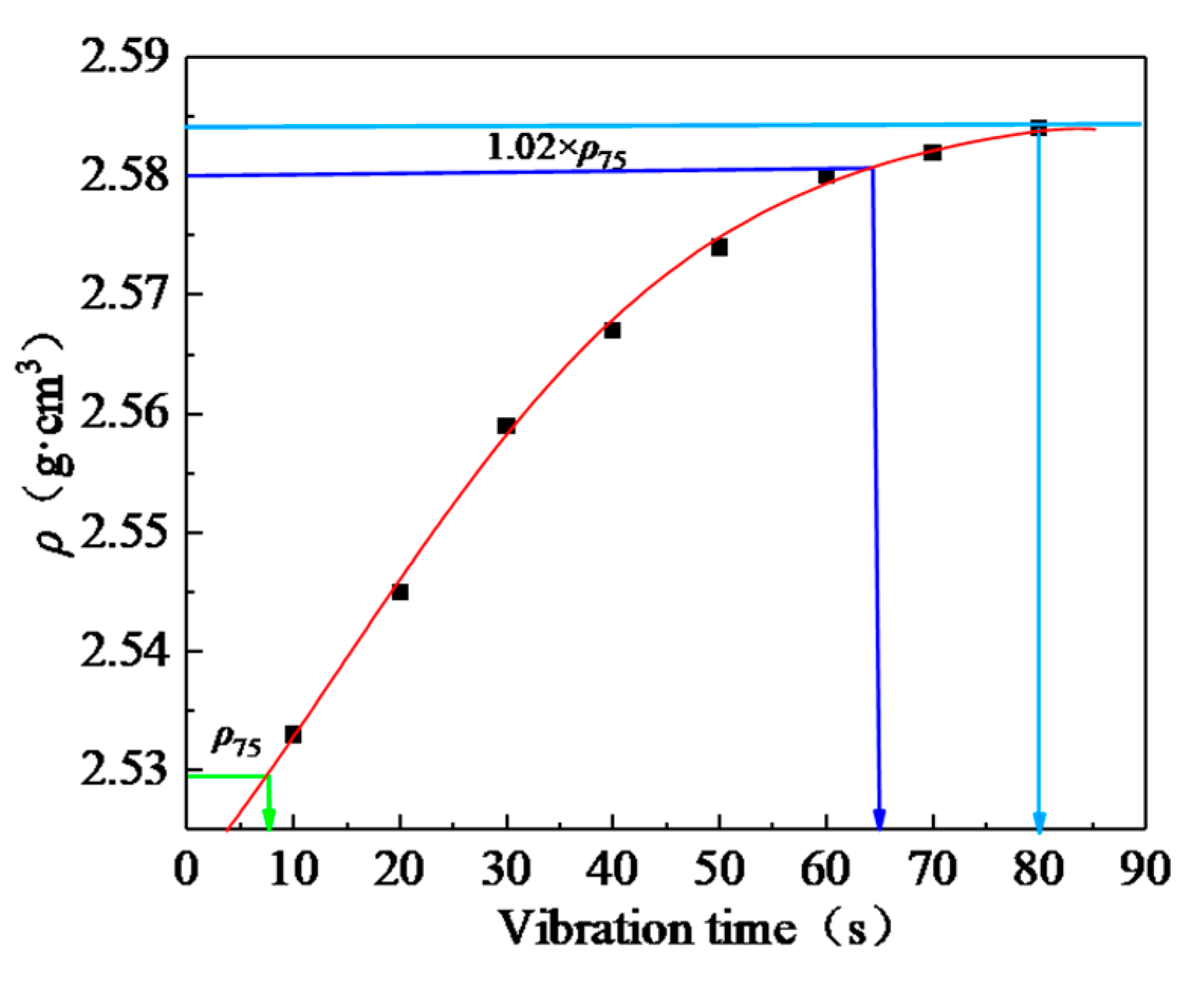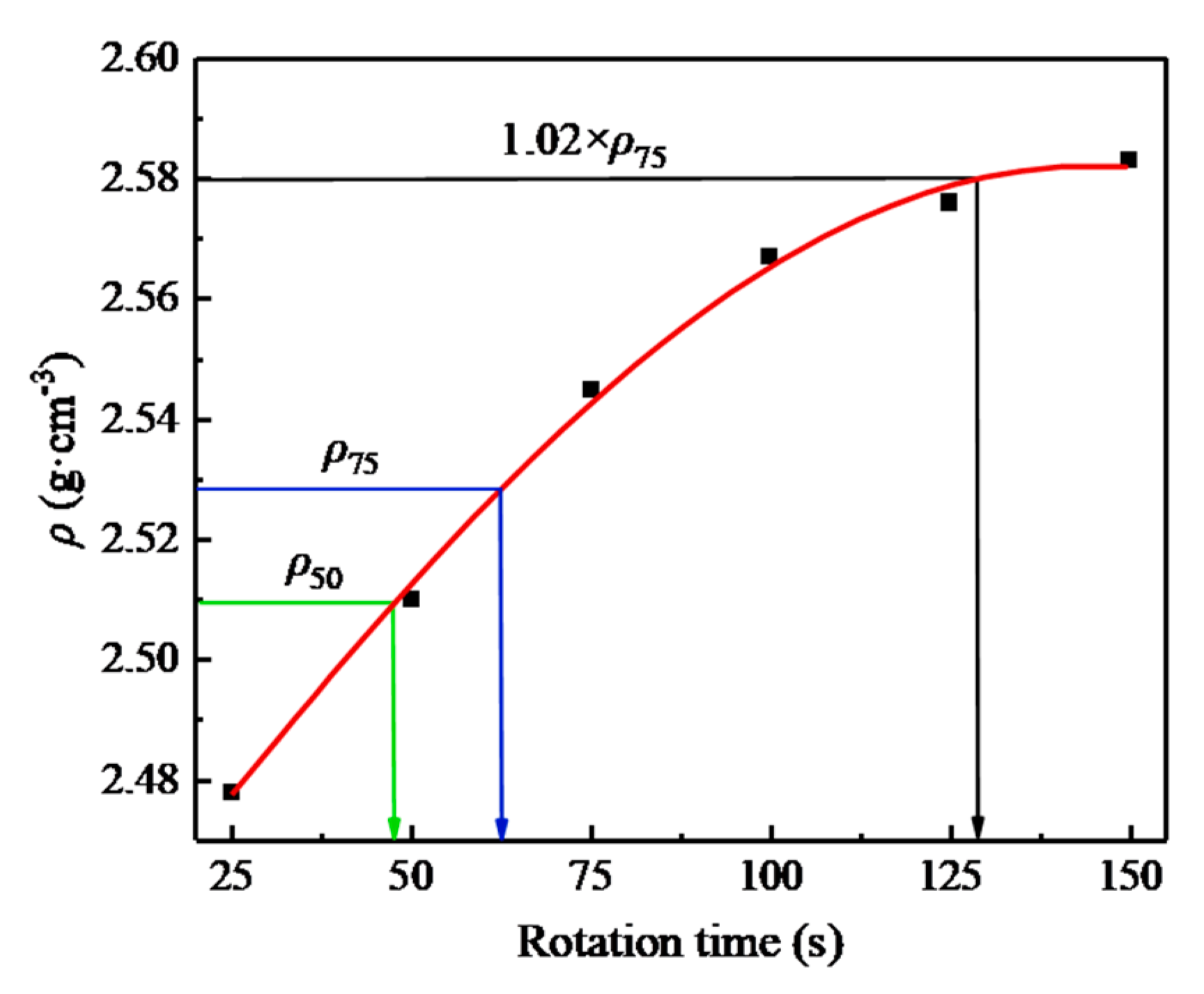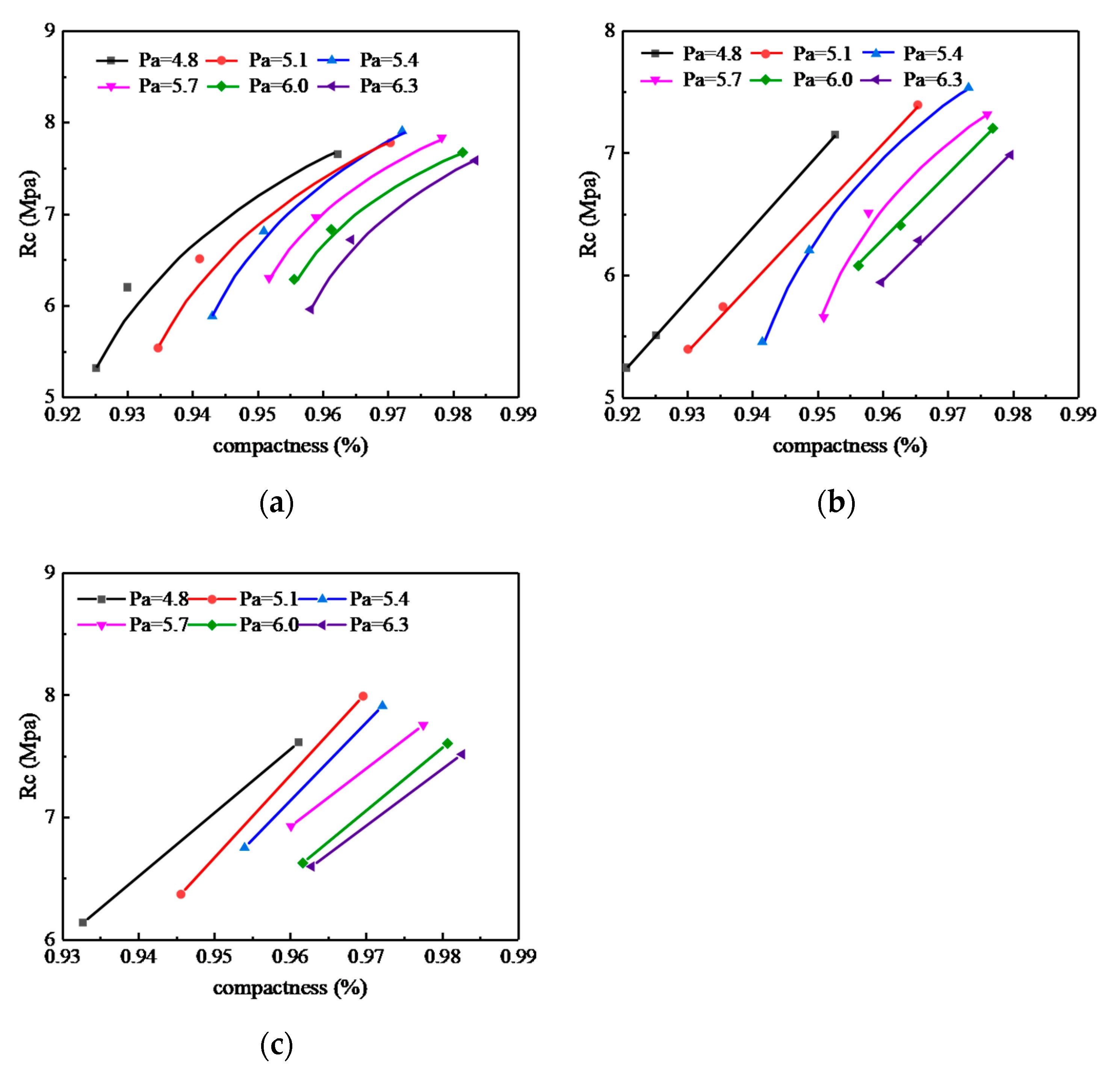Laboratory Evaluation of a Vertical Vibration Testing Method for an SMA-13 Mixture
Abstract
1. Introduction
2. Materials and Methods
2.1. Materials
2.2. Gradation
2.3. Test Methods
2.3.1. Marshall Stability
2.3.2. Compressive Strength
2.3.3. Splitting Strength
2.3.4. Shear Strength
3. Vertical Vibration Testing Method
3.1. Construction of the Vertical Vibration Testing Equipment
3.2. Vibration Time for the Heavy Traffic Compaction Standard
3.2.1. Heavy Traffic Compaction Standard
3.2.2. Vibration Compaction Time
3.3. Testing Process of the SMA Mixture with VVTM
4. Results and Discussion
4.1. Analysis of the Physical and Mechanical Properties
4.1.1. Volume Parameter
4.1.2. Mineral Aggregate Gradation
4.1.3. Mechanical Properties
4.2. Influence of Molding Mothed on the Mechanical Properties
4.2.1. Influence of the Compaction Method on the Mechanical Properties
4.2.2. Influence of Compaction Work on the Mechanical Properties
5. Conclusions
Author Contributions
Funding
Conflicts of Interest
References
- Asi, I.M. Laboratory comparison study for the use of stone matrix asphalt in hot weather climates. Constr. Build. Mater. 2006, 20, 982–989. [Google Scholar] [CrossRef]
- Archilla, A.R. Use of Superpave Gyratory Compaction Data for Rutting Prediction. J. Transp. Eng. 2006, 132, 734–741. [Google Scholar] [CrossRef]
- Kuzniewski, J.; Skotnicki, L. Influence of the Compaction Method on Mineral-Cement Emulsion Mixture Properties. J. Mater. Civ. Eng. 2016, 28, 04016138. [Google Scholar] [CrossRef]
- Georgiou, P.; Sideris, L.; Loizos, A. Evaluation of the effects of gyratory and field compaction on asphalt mix internal structure. Mater. Struct. 2015, 49, 665–676. [Google Scholar] [CrossRef]
- Peterson, R.L.; Mahboub, K.C.; Anderson, R.M.; Masad, E.; Tashman, L. Comparing Superpave Gyratory Compactor Data to Field Cores. J. Mater. Civ. Eng. 2004, 16, 78–83. [Google Scholar] [CrossRef]
- Brown, E.R.; Haddock, J.E.; Mallick, R.B.; Lynn, T.A. Development of a Mixture Design Procedure for Stone Matrix Asphalt(SMA). Available online: https://rosap.ntl.bts.gov/view/dot/13192 (accessed on 1 March 1997).
- Bert, E.; Chung, E.; Dumont, A. Review of stone mastic asphalt design concepts; The National Academies of Sciences, Engineering, and Medicine: Washington, DC, USA, 2009. [Google Scholar]
- Kumar, A.; Goetz, W. The Gyratory Testing Machine as a Design Tool and as an Instrument for Bituminous Mixture Evaluation: Draft Copy; Purdue University Press: West Lafayette, IN, USA, 1974. [Google Scholar]
- Memon, N.A. Comparison Between Superpave Gyratory and Marshall Laboratory Compaction Methods. Ph.D. Thesis, Universiti Teknologi Malaysia, Johor Bahru, Malaysia, 2006. [Google Scholar]
- Ali, G.; Al-Jarallah, M. Properties and Characteristics of Vibratory-Compacted Bituminous Mixes. In Properties of Flexible Pavement Materials; ASTM International: West Conshohocken, PA, USA, 2009; p. 131. [Google Scholar]
- Jiang, Y.; Lin, H.; Han, Z.; Deng, C. Fatigue Properties of Cold-Recycled Emulsified Asphalt Mixtures Fabricated by Different Compaction Methods. Sustainability 2019, 11, 3483. [Google Scholar] [CrossRef]
- Xue, J.S.; Jiang, Y.J. Analysis on the fatigue properties of vertical vibration compacted lime–fly ash-stabilized macadam. Constr Build Mater. 2017, 155, 531–541. [Google Scholar] [CrossRef]
- Wróbel, M.; Woszuk, A.; Franus, W. 2020, Laboratory methods for assessing the influence of improper asphalt mix compaction on its performance. Materials 2020, 13, 2476. [Google Scholar]
- Brown, E.R.; Cross, S.A. Comparison of Laboratory and Field Density of Asphalt Mixtures; NCAT Rep. No. 91-1; National Center for Asphalt Technology: Auburn, AL, USA, 1991. [Google Scholar]
- Tapkın, S.; Keskin, M. Rutting analysis of 100 mm diameter polypropylene modified asphalt specimens using gyratory and Marshall compactors. Mat Res. 2013, 16, 546–564. [Google Scholar] [CrossRef]
- Airey, G.D.; Hunter, A.E.; Collop, A.C.; Zoorob, S.E. Comparison of field and laboratory compacted asphalt mixtures. In Proceedings of the 10th International Conference on Asphalt Pavements, Quebec City, QC, Canada, 12–17 August 2006; Volume 1, pp. 35–46. [Google Scholar]
- Tapkın, S. Optimal polypropylene fiber amount determination by using gyratory compaction, static creep and Marshall stability and flow analyses. Constr. Build. Mater. 2013, 44, 399–410. [Google Scholar] [CrossRef]
- Jiang, Y.; Xue, J. Investigation into physical and mechanical properties of SRX-stabilised crushed rock using different compaction methods. Int. J. Pavement Eng. 2017, 20, 866–873. [Google Scholar] [CrossRef]
- Hartman, A.M.; Gilchrist, M.D.; Walsh, G. Effect of Mixture Compaction on Indirect Tensile Stiffness and Fatigue. J. Transp. Eng. 2001, 127, 370–378. [Google Scholar] [CrossRef]
- Hunter, A.E.; McGreavy, L.; Airey, G. Effect of Compaction Mode on the Mechanical Performance and Variability of Asphalt Mixtures. J. Transp. Eng. 2009, 135, 839–851. [Google Scholar] [CrossRef]
- Iwama, M. Influence of Specimen Size and Orientation on the Mechanical Properties of Laboratory Compacted Asphalt Specimens. M.D. Thesis, Department of Civil Engineering Nottingham Transportation Engineering Centre, University of Nottingham, Nottingham, UK, 2009. [Google Scholar]
- Yaghoubi, E.; Disfani, M.M.; Arulrajah, A.; Kodikara, J.K. Impact of compaction method on mechanical characteristics of unbound granular recycled materials. Road Mater. Pavement Des. 2017, 19, 912–934. [Google Scholar] [CrossRef]
- A Khan, Z.; Wahab, H.I.A.-A.; Asi, I.; Ramadhan, R. Comparative study of asphalt concrete laboratory compaction methods to simulate field compaction. Constr. Build. Mater. 1998, 12, 373–384. [Google Scholar] [CrossRef]
- Airey, G.D.; Collop, A.C. Mechanical and structural assessment of laboratory- and field-compacted asphalt mixtures. Int J Pavement Eng. 2016, 17, 50–63. [Google Scholar] [CrossRef]
- Jiang, Y.J.; Deng, C.Q.; Xue, J.S.; Liu, H.P.; Chen, Z.J. Investigation of the fatigue properties of asphalt mixture designed using vertical vibration method. Road Mater Pavement Des. 2020, 21, 1454–1469. [Google Scholar] [CrossRef]
- Jiang, Y.J.; Fan, L.F. An experimental investigation of optimal asphalt–aggregate ratio for different compaction methods. Constr. Build. Mater. 2015, 91, 111–115. [Google Scholar] [CrossRef]
- Jiang, Y.J.; Han, Z.C.; Xue, J.S.; Deng, C.Q.; Ji, X.P. Laboratory Fatigue Performance of Vertical Vibration Compacted SRX-Stabilized Crushed Rock Material. J. Mater. Civil Eng. 2019, 31, 04019298. [Google Scholar] [CrossRef]
- Jiang, Y.; Xue, J.; Chen, Z. Influence of volumetric property on mechanical properties of vertical vibration compacted asphalt mixture. Constr. Build. Mater. 2017, 135, 612–621. [Google Scholar] [CrossRef]
- Jiang, Y.J.; Deng, C.Q.; Li, Q.; Liu, H. Effect of Compaction Methods on Physical and Mechanical Properties of Asphalt Mixture. J. Mater. Civil Eng. 2019, 31, 04019075. [Google Scholar] [CrossRef]
- Hu, W.; Jia, X.; Huang, B.; Park, H. Evaluation of compactability of asphalt mixture utilizing asphalt vibratory compactor. Constr. Build. Mater. 2017, 139, 419–429. [Google Scholar] [CrossRef]
- Ministry of Transport, People’s Republic of China. JTG F40-2004. In Technical Specification for Construction of Highway Asphalt Pavements; China Communications Press: Beijing, China, 2004. [Google Scholar]
- Goetz, W. The Evolution of Asphalt Concrete Mix Design. In Asphalt Concrete Mix Design: Development of More Rational Approaches; ASTM International: West Conshohocken, PA, USA, 2008; p. 5. [Google Scholar]
- Ministry of Transport, People’s Republic of China. JTG E20-2011. In Standard Test Methods of Bitumen and Bituminous Mixtures for Highway Engineering; China Communications Press: Beijing, China, 2011. [Google Scholar]
- Shafabakhsh, G.; Ahmadi, S. Laboratory investigation of modified bitumen for interlayer in rigid–flexible composite pavement. J. Thermoplast. Compos. Mater. 2020. [Google Scholar] [CrossRef]
- Han, S.; Yao, T.; Han, X.; Hongwei, Z.; Yang, X. Performance evaluation of waterborne epoxy resin modified hydrophobic emulsified asphalt micro-surfacing mixture. Constr. Build. Mater. 2020, 249, 118835. [Google Scholar] [CrossRef]
- Kaya, Z.; Cetin, A.; Cetin, B.; Aydilek, A. Effect of Compaction Method on Mechanical Behavior of Graded Aggregate Base Materials. GeoCongress 2012, 1486–1494. [Google Scholar] [CrossRef]







| Indexes | Penetration (25 °C, 100 g, 5 s) (0.1 mm) | Ductility (10 °C) (cm) | Softening Point (°C) | Kinematic Viscosity (135 °C) |
|---|---|---|---|---|
| Tested Value | 71 | 42.5 | 82.0 | 2.0 |
| Standards | 60–80 | ≥30 | ≥55 | ≤3.0 |
| Sieve Size (mm) | 16 | 13.2 | 9.5 | 4.75 | 2.36 | 1.18 | 0.6 | 0.3 | 0.15 | 0.075 |
| Passing Rate (%) | 100.0 | 95.1 | 62.6 | 27.0 | 20.5 | 19.0 | 16.1 | 13.1 | 12.1 | 10.2 |
| Working Frequency (Hz) | Nominal Amplitude (mm) | Working Weight (kg) | ||
|---|---|---|---|---|
| Upper System | Lower System | Gross Weight | ||
| 37 | 1.2 | 108 | 167 | 275 |
| Test Type | Density (g/cm3) | VV (%) | VMA (%) | VFA (%) | ||||
|---|---|---|---|---|---|---|---|---|
| Tested Value | Relative Value | Tested Value | Relative Value | Tested Value | Relative Value | Tested Value | Relative Value | |
| Marshall | 2.529 | 1.000 | 4.1 | 1.00 | 17.1 | 1.00 | 75.9 | 1.00 |
| Heavy Marshall | 2.575 | 1.018 | 2.4 | 0.58 | 15.6 | 0.91 | 84.6 | 1.11 |
| VVTM | 2.578 | 1.019 | 2.3 | 0.56 | 15.5 | 0.91 | 85.4 | 1.13 |
| SGC | 2.557 | 1.015 | 3.0 | 0.73 | 16.1 | 0.94 | 81.1 | 1.07 |
| Test Type | Passing Rate (%) | |||||||||
|---|---|---|---|---|---|---|---|---|---|---|
| 16 | 13.2 | 9.5 | 4.75 | 2.36 | 1.18 | 0.6 | 0.3 | 0.15 | 0.075 | |
| Marshall | 100.0 | 95.8 | 64.7 | 29.9 | 22.2 | 20.3 | 17.2 | 14.0 | 13.0 | 10.9 |
| Heavy Marshall | 100.0 | 96.9 | 66.9 | 34.5 | 23.4 | 21.1 | 17.7 | 14.2 | 13.1 | 10.9 |
| VVTM | 100.0 | 96.3 | 65.6 | 31.1 | 22.6 | 20.6 | 17.3 | 14.2 | 13.1 | 11.0 |
| SGC | 100.0 | 96.0 | 65.4 | 30.5 | 22.0 | 20.2 | 17.0 | 13.9 | 12.8 | 10.7 |
| Mechanical Strength | RM | RZM | RS | RV | RV/RM | RV/RZM | RV/RS |
|---|---|---|---|---|---|---|---|
| 60 °C Marshall stability (kN) | 14.17 | 17.52 | 18.49 | 19.41 | 1.37 | 1.11 | 1.05 |
| 20 °C compressive strength (MPa) | 6.39 | 7.32 | 7.61 | 7.75 | 1.21 | 1.06 | 1.02 |
| −10 °C splitting strength (MPa) | 3.37 | 4.04 | 4.23 | 4.43 | 1.31 | 1.10 | 1.05 |
| 60 °C shear strength (MPa) | 1.19 | 1.49 | 1.52 | 1.65 | 1.39 | 1.11 | 1.09 |
© 2020 by the authors. Licensee MDPI, Basel, Switzerland. This article is an open access article distributed under the terms and conditions of the Creative Commons Attribution (CC BY) license (http://creativecommons.org/licenses/by/4.0/).
Share and Cite
Jiang, Y.; Fan, J.; Xue, J.; Deng, C.; Yi, Y.; Wang, F. Laboratory Evaluation of a Vertical Vibration Testing Method for an SMA-13 Mixture. Materials 2020, 13, 4409. https://doi.org/10.3390/ma13194409
Jiang Y, Fan J, Xue J, Deng C, Yi Y, Wang F. Laboratory Evaluation of a Vertical Vibration Testing Method for an SMA-13 Mixture. Materials. 2020; 13(19):4409. https://doi.org/10.3390/ma13194409
Chicago/Turabian StyleJiang, Yingjun, Jiangtao Fan, Jinshun Xue, Changqing Deng, Yong Yi, and Fuyu Wang. 2020. "Laboratory Evaluation of a Vertical Vibration Testing Method for an SMA-13 Mixture" Materials 13, no. 19: 4409. https://doi.org/10.3390/ma13194409
APA StyleJiang, Y., Fan, J., Xue, J., Deng, C., Yi, Y., & Wang, F. (2020). Laboratory Evaluation of a Vertical Vibration Testing Method for an SMA-13 Mixture. Materials, 13(19), 4409. https://doi.org/10.3390/ma13194409





